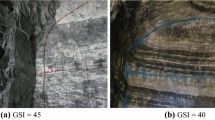Abstract
In this paper, the quantitative Geological Strength Index (GSI) for Singapore’s sedimentary rock mass is determined by applying four different approaches proposed by Hoek et al. (Quantification of the geological strength index chart, 2013), Cai et al. (Int J Rock Mech Min Sci 41(1):3–49, 2004), Sonmez and Ulusay (Int J Rock Mech Min Sci 36:743–760, 1999) and Russo (Improving the reliability of GSI estimation: the integrated GSI-RMi system, 2009) respectively. The relevant rock mass properties, including blockiness and discontinuities surface conditions, of 420 excavated rock faces in a Singapore’s underground excavation project are assessed for such determination. The results obtained by these different approaches are observed falling approximately in the same range between 45 and 55. Moreover, those quantitative GSI results are in good correlation with qualitative GSI which were assessed on excavated rock faces using Hoek et al. (Support of underground excavations in hard rock, Balkema, Rotterdam, 1995) approach. This study demonstrates that the four different approaches perform well by giving similar range of results, although different input parameters are applied in the calculation. A new GSI relationship between joint condition factor Bieniawski (Engineering rock mass classification, Wiley, New York, 1989) and RQD (rock quality designation) is also proposed to better match the qualitative GSI values.








Similar content being viewed by others
References
Barton N, Lien R, Lunde J (1974) Engineering criteria of rock mass for the design of tunnel support. Rock Mech. 6(4):189
Bieniawski ZT (1989) Engineering rock mass classification. Wiley, New York
Cai M, Kaiser PK, Uno H, Tasaka Y, Minami M (2004) Estimation of rock mass deformation modulus and strength of jointed rock masses using GSI system. Int J Rock Mech Min Sci 41(1):3–49
Deere DU (1963) Technical description of rock cores for engineering purposes. Felsmechanik und Ingenieurgeologie (Rock Mech Eng Geol) 1(1):16–22
Hoek E, Kaiser PK, Bawden WF (1995) Support of underground excavations in hard rock. Balkema, Rotterdam
Hoek E, Carter TG, Diederichs MS (2013) Quantification of the geological strength index chart. In: 47th US rock mechanics/geomechanics symposium, American Rock Mechanics Association (ARMA 13-672)
Kar W, Ng M, Wong LNY (2017) Stability analysis of underground storage cavern excavation in Singapore. ISRM Eur Rock Mech Symp Proc Eng 191:1040–1047
Li D, Wong LNY, Liu G, Zhang X (2012) Influence of water content and anisotropy on the strength and deformability of low porosity meta-sedimentary rocks under triaxial compression. Eng Geol 126:46–66
Marinos P, Hoek E (2000) GSI: a geologically friendly tool for rock mass strength estimation. In: GeoEng2000, Melbourne, Australia 2000. CD-ROM
Morelli GL (2015) Variability of the GSI index estimatioed from different quantitative methods. Geotech Geol Eng 33(4):983–995
Morelli GL (2017) Alternative quantification of the geological strength index chart for jointed rocks. Geotech Geol Eng 35(6):2803–2816
Osgoui RR, Ulusay R, Unal E (2010) An assistant tool for the Geological Strength Index to better characterize poor and very poor rock masses. Int J Rock Mech Min Sci 47(4):690–697
Palmstrom A (1974) Characterization of jointing density and the quality of rock masses (in Norwegian). Internal report, A.B. Berdal, Norway, 26 p
Palmstrom A (1982) The volumetric joint count—a useful and simple measure of the degree of jointing. In: Proceedings of the fourth international congress IAEG, New Delhi. vol V, pp 221–228
Palmstrom A (1995) RMi—a rock mass characterization system for rock engineering purposes. Ph.D. thesis, University of Oslo, Norway
Russo G (2007) Improving the reliability of GSI estimation: the integrated GSI-RMi system. In: ISRM workshop underground works under special conditions, Madrid
Russo G (2009) A new rational method for calculating the GSI. Tunn Undergr Space Technol 24:103–111
Sonmez H, Ulusay R (1999) Modification to the geological strength index (GSI) and their applicability to stability of slopes. Int J Rock Mech Min Sci 36:743–760
Acknowledgements
The authors would like to thank JTC Corporation to allow them to publish the Geological Strength Index of sedimentary rock masses determined from geological mapping data of JRC project. The authors also thank the anonymous reviewers for their time and invaluable input which has greatly contributed to this paper. The second author also acknowledges the support from the University of Hong Kong Start-up fund, the Seed Funding Program for Basic Research for New Staff at the University of Hong Kong, the Hung Hing Ying Physical Sciences Research Fund 2017-18, and the support of the “China University of Geosciences Scholar” Program (2017046).
Author information
Authors and Affiliations
Corresponding author
Rights and permissions
About this article
Cite this article
Winn, K., Wong, L.N.Y. Quantitative GSI Determination of Singapore’s Sedimentary Rock Mass by Applying Four Different Approaches. Geotech Geol Eng 37, 2103–2119 (2019). https://doi.org/10.1007/s10706-018-0748-8
Received:
Accepted:
Published:
Issue Date:
DOI: https://doi.org/10.1007/s10706-018-0748-8




